#African Manatee
Text
I am a survivor of Florida, having gone to college there for 4.5 years. There's a lot (a LOT) to not like about Florida, but the wildlife is not one of those things. So for this Wet Beast Wednesday, I'm gonna talk about the most famous Florida resident, the manatee. And why stop there? I'll discuss all the sirenians in one go.
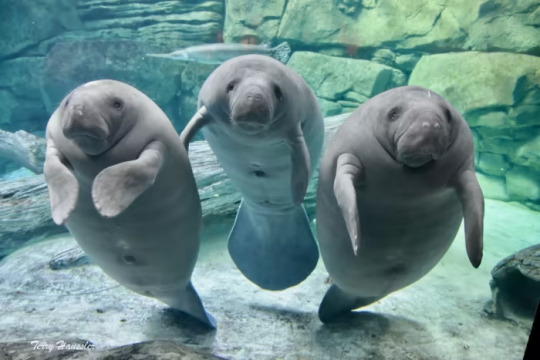
(image: three manatees facing the camera. They are rotund, resembling a potato in shape. Their heads are smaller and end in squarish snouts. They have two flippers at the front of the head. The tail is flat, wide, and round. They are grey all over)
The sirenians are a taxonomic order of marine mammals consisting of 4 living members: three species of manatee and the dugong. They are the only herbivorous order of marine mammals, a trait that has given the the nickname "sea cows". The name Sirenia comes from the sirens of greek myth. In the original story, the sirens were bird with the heads and breasts of women, but later stories turned them into mermaids and that's the version that's stuck. There are unconfirmed stories that European sailors (the most common story uses Christopher Columbus) mistook manatees for mermaids, which is why they're named after sirens.
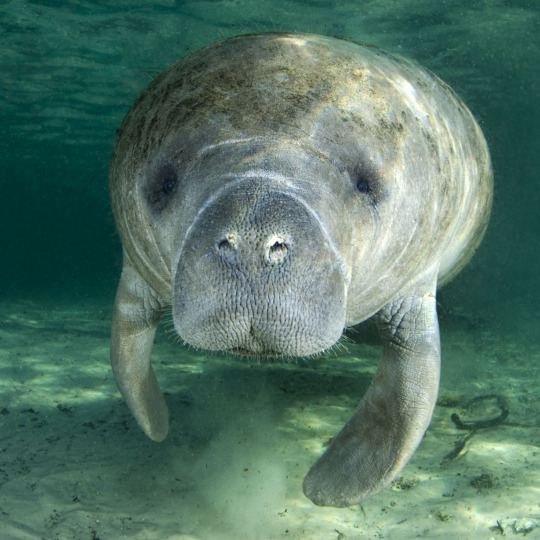
(image: a manatee facing the camera. Its face is visible, revealing two nostrils on a broad, flat shout covered in whiskers. It's eyes are located above the snout and are small and black. It is grey, but has patches of greenish algae growing on it)
Sirenians all have a pretty similar body plan. They are fusiform (bulky in the middle and narrower at the ends) and very bulky animals not built for speed. They don't ned to be fast (though are capable of short bursts of speed) because unlike other marine mammals, they are herbivorous. The vast majority of a sirenian's diet consists of sea grass and most of the rest is other aquatic plants. All species have been known to supplement their diet with invertebrates, mostly during times of poor food availability. When feeding, they move their snouts through the sediment, letting sensory bristles detect plants. They then use their flexible and muscular lips to pull up the sea grass, roots and all. While an individual can eat up to 15% of their body weight a day, they are known to seek out seagrass patches with higher nitrogen content instead of eating everything they can get. This reliance on seagrass limits the range of sirenians to shallow coastal areas, rivers, and estuaries in warm climates. Hearing and touch (with the bristles that cover their bodies) are their main senses. Their eyes are weak, making them almost blind. Sirenians are large, with the largest ever known, Stellar's sea cow, growing up to 10 meters (33 ft) and 11 tons. Mature sirenians are large enough to have no natural predators. Like all marine mammals not named sea otters, sirenians have a thick layer of blubber to keep them warm. Their bones are extremely dense and likely act as ballast to counteract the buoyancy of the blubber. In the marine mammal breath-holding competition, sirenians do pretty bad. They can hold their breath for about 15 minutes at max.
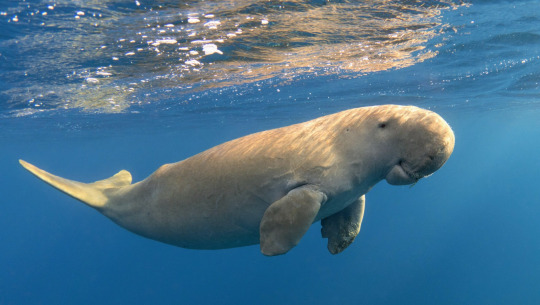
(image: a dugong. It is similar in appearance to a manatee, but skinnier. Its tail is a fluke with two points. Its head is larger and the snout and mouth point downwards)
Sirenian reproduction is somewhat poorly-understood. They only have a single calf at a time (with a gestation period of about a year) and mothers will raise them for one to two years. Calves mature quickly, reaching sexual maturity in around 2-5 years in manatees and 8 years in dugongs, though most females do not give birth until between 6 and 15 years. Their nipples are located behind the flippers, making a nursing calf appear to be sucking its mother's armpit. Sirenians are solitary animals who typically only congregate in groups when females are in estrus. Males are believed to compete for the right to mate and may engage in lekking. Lekking is when a male will claim a territory and mate with females in this territory while chasing opposing males out. Sirenians live long lives, with the oldest known individual being a female dugong that lived to 73. Despite how long they live, each female will only get pregnant a few times in her life.
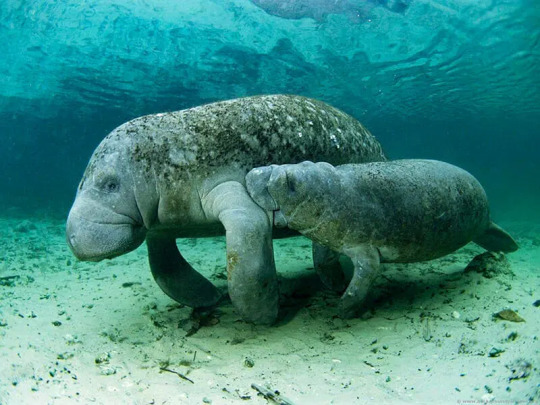
(image: a manatee mother with calf. The calf looks like a smaller version of the mother and is suckling, making it appear to be biting the mother's armpit)
As with all marine mammals, sirenians are descended from land mammals. The study of sirenian evolution has led to a surprising conclusion: the closest relatives of sirenians are elephants. It sounds weird, but there is substantial DNA evidence supporting this conclusion. In addition, the tusks of a dugong (see below) and flexible and prehensile lips of sirenians are based on the same structures as the tusks and trunks of elephants. It gets better, the next closest relative of both groups are the hyraxes, who look more like rodents than anything that should be related to an elephant or a manatee. All three are part of a clade called paenungulata, which is part of a clade called afrotheria. The other main group within afrotheria is afroinsectiphilia, which consists of aardvarks and various shrews. The afrotherian family reunions must be wild.

(image: a scientific diagram showing a cladogram of afrotheria and the groups within it. source)
The dugong (Dugong dugon) is the last surviving member of its family, which also included the now extinct giant Stellar's sea cow. The easiest way to tell a dugong apart from a manatee is its tail, which is shaped like a dolphin's fluke instead of the round tails of manatees. Internally, there are also multiple differences, many of them relating to the skull. The skull has a very distinct shape, with the upper jaw bending down at a sharp angle. The tip of the upper jaw has two short tusks emerging from it. These tusks are found in moth males and females, but develop differently. In males, they emerge when the calf reaches sexual maturity, while those of females only emerge later in life and sometimes not at all. It is believed that these tusks are used by males to fight over females, as males are often found with scars matching the shape of the tusks. Dugong teeth as simpler than those of manatees, being simple pegs. While manatee teeth will be replaced continuously through life, dugongs only get one set and have to make it count. Dugongs reach an average length of 3 m (10 ft) and 420 kg (930 lbs). Dugongs have the largest range of any sirenian, stretching from east Africa to the Solomon islands east of Australia. This range is fragmented rather than continuous and dugongs are separated into multiple isolated populations. The largest population is believed to exist in northern Australia.
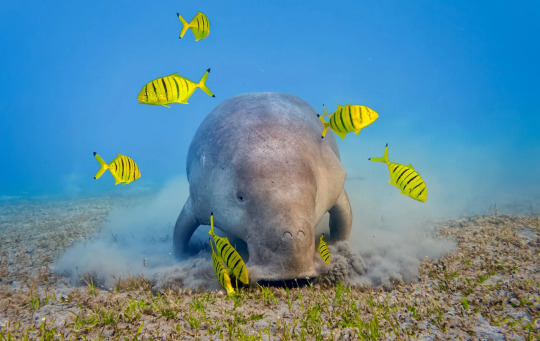
(image: a dugong feeding on seagrass, seen from the front. It's snout is being dragged through the sediment, leaving a cloud of dirt behind it. Small yellow fish surround it)
The west Indian manatee (Trichechus manatus) does not live in west India. It lives in North America. I dunno who named it, but you had one job. The species is divided into two subspecies: the Florida manatee (T. m. latriostris) found in the Gulf of Mexico and east coast of the United States, and the Antillean manatee (T. m. manatus) found in the Caribbean and down south to Brazil. The Antillean subspecies is much more poorly known compared to the Florida subspecies. The Florida manatee may be the most well-studied of all manatees due to the extensive conservation efforts regarding them since the 1970s. Like other manatees, the WI manatee has a round, paddle-like tail and fingernails on its flippers. Their diaphragms are divided into two hemidiaphragms, each of which contracts one lung. They have the northernmost territory of all manatees, which comes with some consequences. They are susceptible to stress and even death when exposed to water under 20 degrees C (68 F). They travel south during winter, usually to southern Florida, but conservationists still have to rehabilitate manatees harmed by cool water every year.
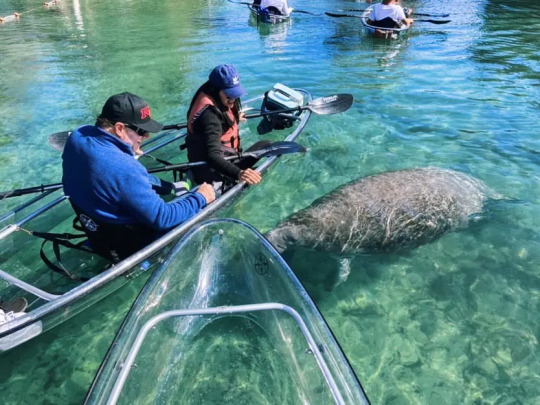
(image: tourists in transparent kayaks observing a west Indian manatee swim below them)
The Amazonian manatee (Trichechus inunguis) is the only sirenian that lives entirely in freshwater, residing in the Amazon river basin. They move seasonally inhabiting flooded areas during the wet season and lakes during the dry season. They fast during the dry season, subsisting off of their fat stores. There are believed to be multiple relatively isolated populations of Amazonian manatee, but studying them is difficult due to them preferring to live in areas away from humans. The Amazonian manatee is the smallest sirenian, reaching between 160 and 230 cm (5 ft 4 in to 7 ft 7 in) and 120 to 270 kg (265 to 595 lbs). Scientist Marc van Roosmalen has proposed the existence of a related species, the dwarf manatee, that lives only in one tributary of Aripuanã river, which is in the habitat range of the Amazonian manatee. Their existence is debated, but most manatee scientists think that they are misidentified juvenile Amazonian manatees.

(image: an Amazonian manatee with calf, seen from ahead and below. they have the same body plan as the above images, but are a darker grey with a white patch on the stomach)
The African manatee (Trichechus senegalensis) is the only species found in the old world, in west Africa from Senegal to Angola. They occupy the largest range of habitats of all sirenians, from tropical islands to flooded forests, to offshore sand flats, to lakes and rivers. They will swim up river during the wet season and back down during dry season. Some isolated populations live exclusively in rivers, never venturing out to sea. They are the most omnivorous of the sirenians, seeking out invertebrates to eat and stealing fish from nets. Many cultural groups in their range consider the African manatee sacred, some saying they used to be people and that killing one requires paying a penance. Mami Wata, a water spirit revered in throughout west, central, and south Africa, has been identified with manatees by some folklorists.

(image: an African manatee seen from the side in an aquarium. It looks almost identical to the west Indian manatee)
All sirenians are classified as vulnerable by the IUCN, except for the Antillean manatee, which is endangered. As they have few to no predators as adults, the primary threats for all sirenians come from humans. Boat strikes and getting tangled in nets kills and injures many individuals, possibly more than die of natural causes. This is not helped by them lacking fear responses to predators, meaning they don't flee from humans and boats. All species were historically hunted for their meat, blubber, and bones, reducing their populations. While all species are now legally protected, poaching and legal hunting by indigenous groups still occurs. They are also threatened by habitat loss as coastal development, pollution, and climate change reduces the range of seagrass. Damming has also reduced their ability to travel up rivers, cutting off valuable feeding ground. Learning about freshwater ecology will make you despise dams. In the United States, the west Indian manatee has become an icon of conservation, especially in Florida, where they have extensive legal protections. Controversially, the US government reduced their legal protections in 2017, much to the ire of many conservation groups. The manatee is the state marine mammal of Florida, presumably narrowly beating out dolphins and meth heads wandering around the everglades.

(image: two juvenile manatees who were abandoned by their mothers. They are being bottle fed by employees of the Cincinnati zoo. Ideally, they will be able to be released into the wild once weaned)
#wet beast wednesday#sirenia#manatee#dugong#west indian manatee#amazonian manatee#african manatee#marine biology#biology#zoology#ecology#animal facts#marine mammals
458 notes
·
View notes
Text
For #ManateeAppreciationDay:


1. original watercolor by Joseph Wolf (German, 1820-1899) for ZSL, 1879 via ZSL Library
2. published version, plate 7 in Biologia Centrali-Americana: Mammalia, 1879-1882 via BHL
More info via ZSL Library:
"Watercolour on paper, in window mount ; art - 35 x 27 cm., mount - 57.5 x 44.5 cm. Signed by artist in black paint in lower right corner: 'J. Wolf. 1879'."
"Mss title in ink and pencil, in unidentified handwriting, on label pasted on mount: 'Manatee (Manatus americanus) from a specimen living in the Westminster Aquarium 1879. See PZS 1879'."
"According to the caption the painting was made of an animal living in Westminster Aquarium. A manatee - said to be Manatus americanus - was living in the Westminster Aquarium in 1879 and a note about it by Dr James Murie was published in 'PZS' 1879 : 552. This refers to Murie's forthcoming paper on that manatee based on observations of the great mobility of the upper lip and use of the limbs in feeding when it was living in the Aquarium and brain structure (after it died). This paper was published : Murie, J. (1880) 'Further observations on the manatee', 'TZS' 11 : 19-48 5 pls (by C. Berjeau). On p. 21-23 Murie states the adult female manatee was caught in a net on the Dauntless Bank, off the Island of Lequana, near the mouth of the Essiquibo River, British Guiana, taken to London and purchased by the Aquarium in June 1878. It died on 15 March 1879. Wolf's painting is [therefore] presumably of the West African manatee, Trichechus senegalensis."
🆔Manatee, likely West African Manatee (Trichechus senegalensis); Kingfisher, likely Giant Kingfisher (Megaceryle maxima)
FYI, there are three living species of manatee, and Wolf's illustration has gone through the confusion of first being misidentified as one, then another, before finally being correctly recognized as the third! More info on the blog:
#animals in art#animal holiday#european art#19th century art#illustration#manatee#kingfisher#bird#birds in art#Giant Kingfisher#African Manatee#West African Manatee#BHL#ZSL#ZSL Library#book plate#lithograph#watercolor#painting#Joseph Wolf#natural history art#scientific illustration#species ID#Manatee Apprecation Day
19 notes
·
View notes
Text
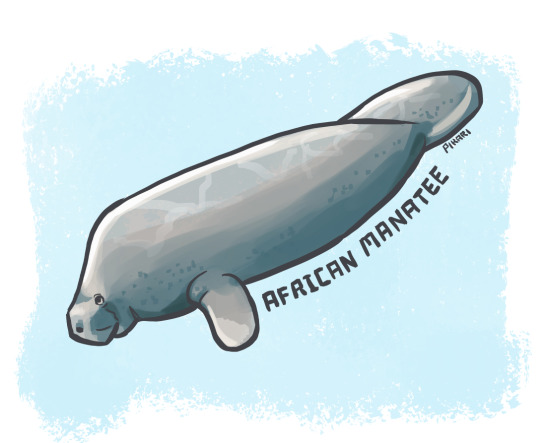
African Manatee (Trichechus senegalensis)
West African coast and rivers
Status: Vulnerable
Threats: dams, hydroelectric power, poaching, development
#drawing manatees is just like... *manatee shape* and then you're done#african manatee#artists on tumblr#animal art#marine mammals#manatee art#endangered species#oceans#illustration#blue aesthetic#huevember#ocean art#africa#west africa#mammal#manatee
20 notes
·
View notes
Text
Manatee Capture and Release: First Documentation in Rogolié River Wetland, Gabon
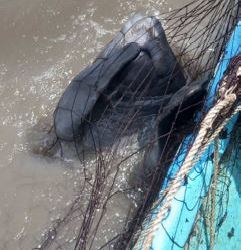
Abstract
A large number of marine mammals are seriously threatened by fisheries. Although the issue of by-catches in fisheries is a major threat to marine mammals, it has not yet been tackled in a concrete way in Gabon. Artisanal fishing accounts for 95% of fishing activity. Their impact on vulnerable megafauna can therefore be significant, either as bycatch or as target species. However, detailed information on the composition of fisheries catches is limited because of a lack of monitoring and reporting due to limited financial and logistical capacity. The aim of this paper is to document a rare phenomenon of the release of an African manatee (Trichechus senegalensis) caught in fishing nets at the mouth of the Rogolié River in the Gabon estuary.

Introduction
Of all sirenians species the West African manatee (Trichechus senegalensis) is the least well known biologically (Reynolds and Odell 1991). The species is considered vulnerable by the IUCN (Keith Diagne, 2015) due to the persistence of a wide range of threats, primarily of human-induced. This species occurs in most of the coastal marine waters, brackish estuaries, and adjacent rivers along the West African coast from southern Mauritania (16°N) to the Cuanza and Longa Rivers in Angola (9°S) (Dodman et al. 2008; Perrin 2001; Powell 1996; Grigione 1996; Nishiwaki 1984; Husar 1978; Robinson 1971; Blancou 1960; Beal 1939). Gabon may have one of the highest densities of Manatees remaining in Africa (Nkollo 2022; Powell 1996). The decline of the Trichechus senegalensis population has been largely attributed to hunting and incidental capture in fishing nets (Dodman et al. 2008; Blancou 1960; Cadenat, 1957).
Bycatch in fishing gear is also a major threat in all African countries, and even when caught alive, most manatees caught incidentally are not released, but killed (Nkollo 2017; Mbina 2001).
The aim of this note is to document the phenomenon of accidental captures and rescue efforts for the African manatee, a vulnerable species. We believe that the lessons learned from this event can be beneficial to manatee conservation stakeholders and can contribute to the development of better manatee release practices.
Source : Manatee Capture and Release: First Documentation in Rogolié River Wetland, Gabon | InformativeBD
1 note
·
View note
Photo




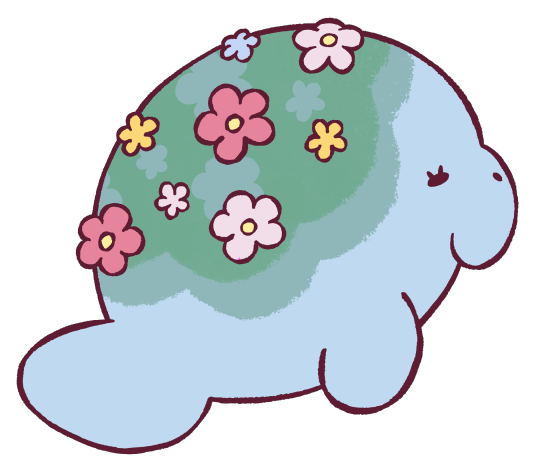
funny guys i designed for class based on endangered species
#african wild dog#red panda#axolotl#manatee#character design#the manatee was the class favorite! shes famous already <3
267 notes
·
View notes
Text

West African manatee
By: Unknown photographer
From: WWF Threatened Animals
1986
111 notes
·
View notes
Photo

Sirens of the Sea
Here’s something different; not cetaceans, but marine mammals for sure. A fun challenge from one of last year’s commission. Definitely a ways outside of my normal comfort zone, but I think they turned out okay. (Dugong and Manatee experts will no doubt be able to spot some blaring mistakes lol). I especially enjoyed painting the Dugong. Very weird, but cute at the same time. And their heads have a nice shapeliness to them. That’s nice for drawing. The manatee by contrast felt a bit more “blobby” and hard to make look right. I hope you’ll like these two Sirens - the order’s scientific name coming from a legend regarding their discovery: lonely sailors would have mistaken them for mermaids, like the sirens of Greek Mythology.
We’re almost through the (rather huge) list of illustrations from last year’s commissions by the way. Just baleen whales to go - and then..? I’m not sure because I still haven’t painted anything this year. A bit appalling how busy things stay. Hopefully soon.
#scientific illustrations#illustrations#Dugong#Dugong dugon#West African manatee#manatee#Trichechus senegalensis#sirenia#sirenians#sirens#marine mammals#digital art
79 notes
·
View notes
Text
Florida Days Six: Key Largo. A Walk Through A Quiet Neighborhood And Along A Busy Canal With A Manatee Sighting.
There was little rest for me on my recent visit to the Everglades and the Florida Keys. I pretty much was active from dawn to dusk every day, hiking, editing photo working on my blog and eating. I was also checking in with my office and returning calls and emails. This wasn’t the plan. I was going to try and get some more relaxation in on this trip and work on my tan at the pools in my hotels.…

View On WordPress
2 notes
·
View notes
Text
Shit sucks but the world’s still magical.
0 notes
Text


1 note
·
View note
Text
Okay I don't want to stay with mammals for much longer so I'm gonna go through the rest of them here
There are 22 distinct groups of mammals, I've already covered three of them (Carnivora and the even and odd-toed ungulates).
Going through the remaining 19:
There are four groups of marsupials, but that doesn't matter because Rahi-wise there is only one species, the Fusa, a kangaroo. The Kikanalo might also count, but see my ungulate post for that ramble.
There are two groups of Xenarthra (armadillos, sloths, and anteaters) but there are no rahi equivalents at all.
Monotremes (echidnas and platypuses) have no representation either.
Same with Sirenia (manatees and dugongs), Lagomorphs (rabbits), Scandentia (tree shrews), Macroscelidea (elephant shrews), Erinaceidae (hedgehogs), and Afrosoricida (tenrecs and some other miscellaneous small African mammals).
Soricomorpha (shrews and moles) has one representative, the Archives Mole.
Pachyderms likewise also only have one rep, the Hapaka.
Cetaceans only have two reps, the Razor Whale and the Stinger Whale. There is a unique whale rahi in the 2003 console game, but much like with the unique fox rahi, I don't know if I can consider it canon given the nature of the game and how drastically different many canon rahi appear in it.
Chiroptera has three reps, the Cliff Screecher, the Ice Bat, and the unnamed bat rahi from the cancelled pc game and various other 01 promo renders.
There are three primates, the Brakas, a monkey, and two apes, the Lava ape and the Spiny Stone Ape. Much like with the Kavinika, I have some questions regarding if the Spiny Stone Ape is actually an ape, given that it has a tail and frankly, kind of looks like a dinosaur, but that's a discussion for another day.
Lastly, the rodents, of which there are quite a lot. There's the Gafna, the Ice Vermin, the Kinloka, the Kuma-Nui, the Lava Rat, the Stone Rat, and the Wolf Rat from the cancelled pc game. The Kuma-Nui and Wolf Rat are especially interesting considering that the former is really fucking huge, and the later engages in some interesting specevo, being a species of one group filling in the role of a species belonging to a different group.
There, that's every mammalian analogue rahi charted
19 notes
·
View notes
Note
manatee please? or naked mole rat
I've already done a post on a species and subspecies of manatee but I can totally do a naked mole rat! I hope my manatee posts will keep you busy until I find information on the adorable not-a-mole, not-a-rat, naked mole rat.
32 notes
·
View notes
Text

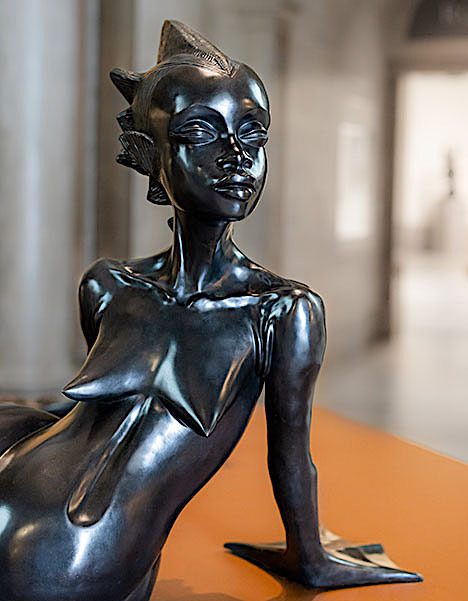
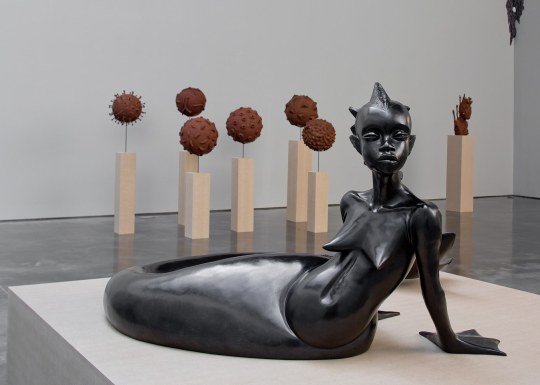
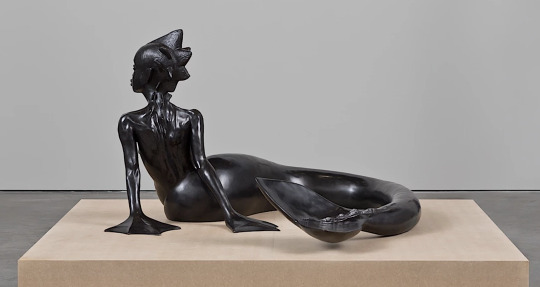
Water Woman ~ bronze ~ Wangechi Mutu
Gallery Note: She gazes east across the lagoon, looking away from the approaching viewer, her ebony skin catching the sun and large tail curling behind her. Water Woman, 2017, a cast bronze sculpture by the artist Wangechi Mutu (Kenyan, born 1972 in Nairobi, lives and works in Nairobi and New York), sits perched atop a grassy mound at the foot of the amphitheater in the museum’s fourteen-acre sculpture park at Laguna Gloria. Rooted in myth and mystery, this siren figure—evocative of a mermaid—references both the dugong, an endangered relative of the manatee found in warm coastal waters from East Africa to Australia, and the East African folkloric legend of the half woman, half sea creature who entices and eludes (nguva in Swahili). ~ https://www.victoria-miro.com/news/777
@lagaleriapopurri
72 notes
·
View notes
Photo
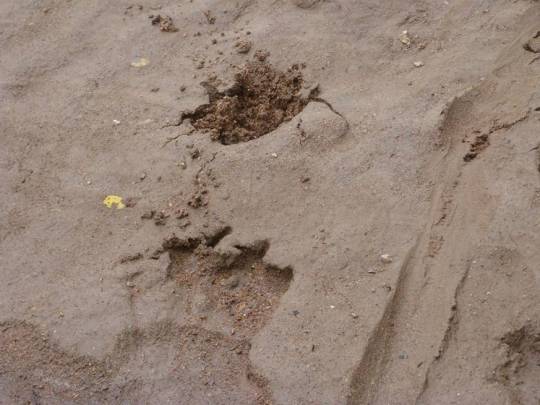
Cryptid of the Day: Jago-Nini
Description: According to Ivory trader “Trader Horn”, there lives a monster in the Gabon swamps that resemble a dinosaur. Much like the Mokele-mbmbe, the Jago-Nini is described to be a sauropod. According to Trader, he said that the animal feasted on West African manatees and human beings.
41 notes
·
View notes
Text

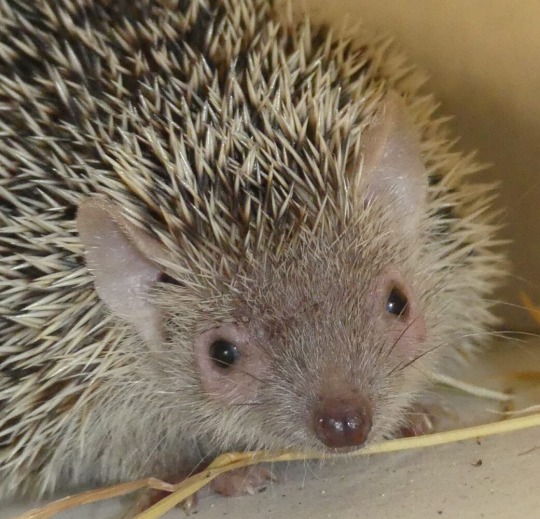


Lesser hedgehog tenrec
Echinops telfairi
Family tenrecidae, order Afrosoricida, superorder Afrotheria (the elephants, sengis, manatees, aardvarks, and hyraxes)
These guys bear an uncanny resemblance to another African animal: the four toed hedgehog.

But four toed hedgehog’s are in an entirely different clade! Laurasiatheria, like pangolins, cats, dogs, moles, deer, and rhinos.
All tenrecs have a cloaca like reptiles, so these guys only have one hole to excrete waste.
They’re terrestrial and spend the day curled up sleeping under leaves, logs and anything else they can hide under. If it’s really hot, they sleep splayed out.
They eat insects and sometimes small vertebrates. They forage alone with the exception of mothers foraging with young.
They’ve become common exotic pets. I’ve held one before.
These guys are in a relatively new proposed clade: Afroinsectiphilia. These guys are afrotherians that were thought to be in Insectivora, which is not considered a legitimate group anymore.
@jackalspine @lemon-snake
12 notes
·
View notes